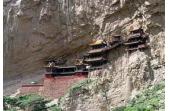Hanging Monastery
- Things to do
-
- Photo(10)
- Tips&article(22)
- Make it Happen
- Map
-
loading...
Top 5 Lists
-
3.
Lama Temple
-
4.
Lama Temple
-
5.
Mt. Emeishan
Summary
This unique monastery hangs 50 meters above the ground on the cliff side, and it is the only one in China which enshrines three religions within one monastery.
Introduction
The Hanging Monastery is located at the foot of Heng Shan (Heng Mountain, or Mt. Hengshan), which is one of the Five Sacred Mountains in China. The Hanging Monastery, which is Hengshan Mountain's principal attraction, pays homage to Confucianism and Taoism as well as to Buddhism, with sculptures of Confucius and Lao-Tzu alongside sculptures of the founding father of Buddhism, Sakyamuni Buddha.
Suspended some 50 meters over the ground and consisting of 40 pavilions and halls, the Hanging Monastery was actually constructed without the help of wooden pillars that appear to support. When the monastery was built the pillars weren't here, but they were added later because many people wouldn't dare to climb up to the monastery worrying it would fall. The pillars are actually moveable and can even be taken away. Thanks to the excellent workmanship and building technique, the monastery has been very safe ever since its completion, even without the pillars.
The monastery is reached via a bridge that leads up a stone staircase that has been chiseled into the cliff face. The monastery's 6 main halls are intricately and ingeniously linked by winding corridors, bridges, and boardwalks that offer a perilous glimpse of the ground below, increasing the visitor's awareness that this truly is, quite literally, a hanging monastery.

Pillars under the monastery


Narrow stairs


Statues inside the monastery

Religion and Exhibitions
The temple boasts a fine collection of statues – 80 in all – including statues in bronze, iron, terracotta and stone, all are remarkably true-to-life. The most outstanding feature of the Hanging Monastery, however, and something which continues to provide encouragement to those who seek universal, or cross-sectarian, religious understanding and cooperation, is the side-by-side presence of the sculptures of Lao-Tzu, Confucius, and Sakyamuni, the founders of the three main religions of China: Taoism, Confucianism, and Buddhism, respectively.
Due to its relatively remote location, the Hanging Monastery served as sort of a transit station where travelers who passed here could grab a bit and take a rest. Because religion was prevalent at that time, and people were reluctant to get into places which worshipped other religions rather than their own, the Hanging Monastery enshrined China’s three major religions so that more travelers can stay there.
Travel Essentials
- Ticket fare: 130 yuan per person
- Opening time: 8:30-17:30 (winter); 8:00-18:00 (summer)
- Location: 65 kilometers southeast of Datong City, taking one and a half hours by car
Related Links
- Mia's travel story with pictures
- One-Day Datong Extension Tour including Hanging Monastery and Yingxian Wooden Pagoda
- Datong Tour Packages
- Religions in China
- China's Architecture
Tips & articles
|
|
|
forum discussion
|
|
|










